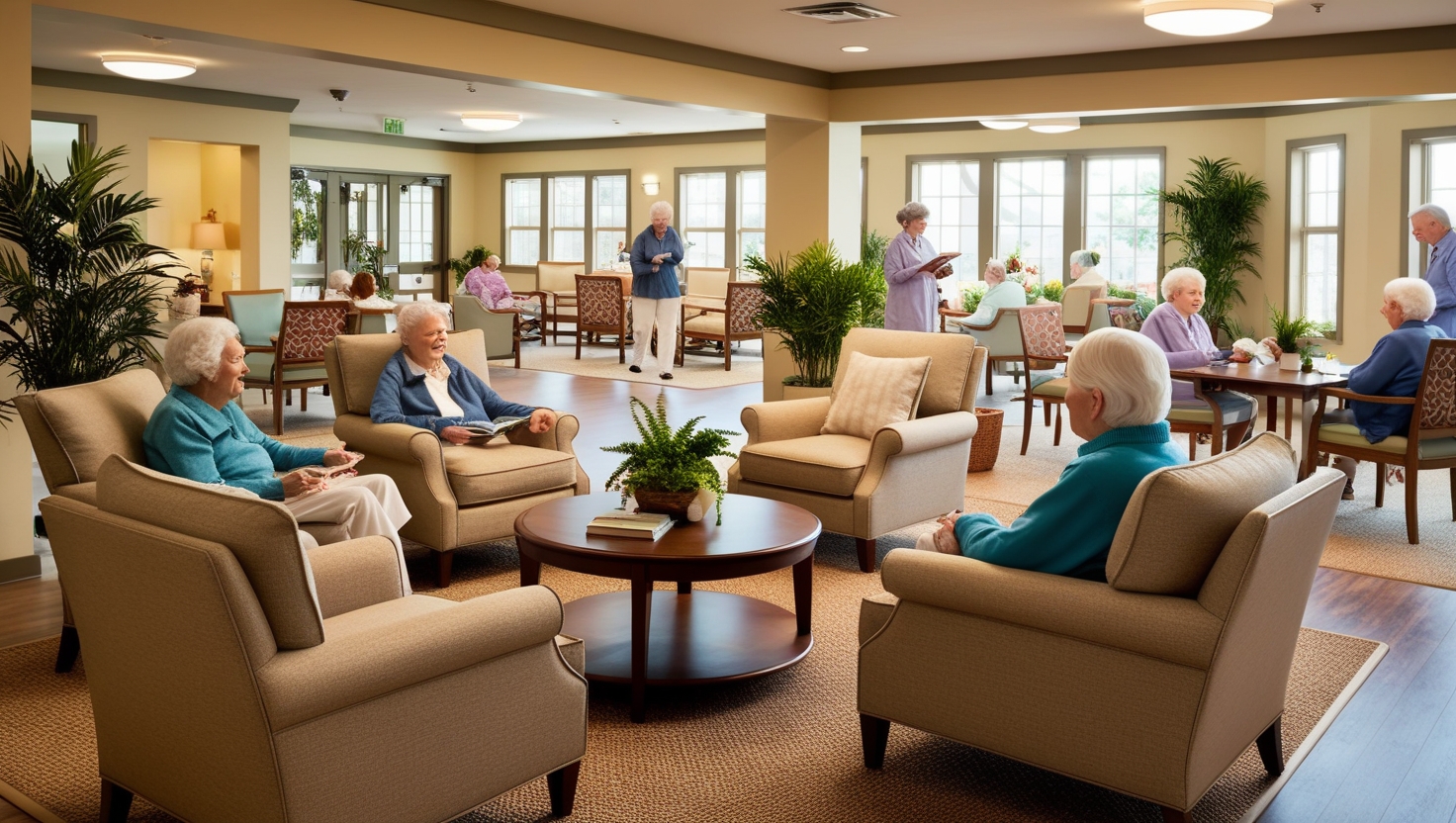How Does Assisted Living Work: Assisted living is a continuum of care that falls between independent living and full-time nursing care. The philosophy behind it give supportive care to older adults needing assistance with activities of day-to-day living while still desiring some independence. The balance of this paper will explain how assisted living works, including what services are included, and how to determine whether such a lifestyle is right for one or a loved one.

Assisted Living: Understanding the Basics
Assisted living facilities are residential communities designed for elderly persons who require assistance in certain daily tasks but do not need the intensive care provided by nursing homes. The goal is to enable residents to live comfortably in a supportive environment by supplying them with assistance with personal care, medication management, and other daily needs.
What Services Are Provided?
Personal Care Assistance:
Major assistance in assisted living facilities includes personal daily living activities. These range from bathing, dressing, and grooming through to toileting. The care providers see to it that all these needs are taken care of for all residents whenever needed and with their dignity and comfort at heart.
Medication Management:
Assisted living facilities will also provide medication management where professional staff will remind the residents when to take their medications and assist in administering such medication by calling their respective healthcare providers for prescription monitoring and changes.
Meal Services:
Most assisted living communities offer three meals a day and snacks. Such meals are usually prepared by expert chefs and aim to meet seniors’ nutritional needs. Accommodation for special diets and food preferences is usually made.
Housekeeping and Laundry:
This is to lighten the chore burden on the resident as much as possible. Assisted living communities will offer housekeeping and laundry. This includes cleaning the resident’s living space, changing bed linens, and doing the laundry.
Social and Recreational Activities:
Social contact and meaningful activity engagement are a great part of the lives of older adults. Because of this, the majority of assisted living communities have developed social and recreational programs that include exercise classes, arts and crafts, movie nights, and outings.
Transportation Services:
Many of the facilities offer resident transportation to doctor’s appointments, shopping, and social activities. This allows residents to continue independent lifestyles by accessing basic services.
24/7 Staff Availability:
Facilities have staff present on-site at all times to handle emergencies, offer assistance, and ensure the residents’ safety. This includes a registered nurse, personal care aide, or other medically trained personnel.
Types of Assisted Living Facilities
There are different types of assisted living to meet varying needs and individual preferences. The major types of assisted living include:
Assisted Living Facilities:
These are large communities of residents offering a range of services and amenities. They provide different apartment styles with common areas for socializing and activities.
Small Residential Care Homes:
Also called board and care homes, these houses are smaller in scale and far more residential; thus, more intimate and homelike. Generally, they have fewer residents and a higher staff-to-resident ratio.
Continuing Care Retirement Communities (CCRCs):
These offer a continuum of care, from independent living through assisted living and skilled nursing care, on one campus. With this continuity of care, residents can move as their needs increase, often seamlessly into higher levels of care.
Memory Care Facilities:
These are specialized facilities for people with Alzheimer’s disease or other dementias. They offer secure environments and programs that are designed to support residents with memory impairments.
Choosing an Assisted Living Facility
Getting the appropriate assisted living facility involves several aspects that ensure the needs and preferences are well looked after. Here are some issues to be looked at: Assessing Needs: The very first thing one needs to establish is the level of care and support needed. This involves considerations like ailments, mobility, and life support concerning daily needs.
Location:
You will want to choose a facility that is close and convenient to visit with family and friends and have access to medical services. Being close to friends and family can greatly affect the resident’s quality of life.
Cost and Financing:
Research the cost structure of the home, including general monthly costs and extra services. Explore options for financing a stay in the home, such as long-term care insurance, veterans’ benefits, or personal savings.
Facility Tour:
Visit potential facilities to assess the environment, cleanliness, and general atmosphere. Speak with staff and current residents to get a feel for the community and its services.
Licensing and Accreditation:
The facility should be licensed and accredited by respective state agencies/organizations. This shall be an assurance of safety as well as adherence to quality standards.
Service Flexibility:
Evaluate the facility’s ability to adapt to changes in needs. For example, see whether they will be able to handle your needs in case these increase or should you have special dietary needs.
How Assisted Living Works: A Day in the Life
To understand exactly how assisted living works, let’s peek into a typical day for a resident:
This could include breakfast being eaten in the dining room or personal care if required. Some attend a morning exercise class or merely walk around the facility.
Daily Activities:
For much of the day, a resident might take part in some daily activities selection that may involve social activities, hobbies, or outings. Many communities have programmed activities, services, and events to help keep residents active and stimulated.
Meal Times:
Lunch and dinner are provided in the main dining area where residents have the chance to enjoy nutritious meals with others. Special diets are usually accommodated, and there is often a menu for residents to choose from.
Evenings:
After dinner, the residents can view evening entertainment participate in a group activity, or go back to their apartment. Some will also offer night support, including safety checks and responding in case of an emergency.
Health Overview:
Throughout the day, the resident’s health and well-being are tracked. This includes following a change in condition, supervising drugs, and action as needs arise.
Benefits of Assisted Living
Assisted living offers a few key benefits, both to the seniors and their families, in such aspects as the following:
Enriched Quality of Life:
Through supportive care in a residential environment offering independence and socialization with support of certain needs.
Safety and Security:
With on-site staff 24/7 and emergency response systems, residents can have confidence in the safety of their homes.
Reduced Burden to Caregiver:
The families are very confident that their loved ones are receiving professional care and support, thereby reducing the stress and burden at the core of every family caregiver.
Assistance with Services and Amenities:
Availability of services such as meal preparations, housekeeping, transportation, and more, which are hard to tackle by residents themselves.
Social Opportunities:
Events and activities within assisted living communities promote socialization and involvement that help residents fight off isolation and loneliness.
Challenges and Considerations
Although some positive aspects of assisted living exist, there are also various challenges and considerations:
Costs:
Assisted living is extremely expensive, and these costs may vary by facility and level of care. It is prudent to plan and research financing options in advance.
Embracing Change:
The change to assisted living will be a big adjustment for the elderly and their families. It can be quite an emotional experience to adjust to this new environment and routine.
Personal Preferences:
Each assisted living facility is different, and personal preferences should be considered location, amenities, and care services in mind.
Medical needs:
The level of care that assisted living provides is inadequate for people with complicated medical needs, and they require more medical care or services.
Conclusion
Understanding how assisted living works can show how to make choices regarding senior care. Assisted living provides an engaging, stimulating environment for seniors who need assistance with daily tasks but cherish their independence. Families can ensure that their loved one has everything they need to thrive in assisted living by evaluating the services provided, selecting an appropriate facility, and weighing the advantages and disadvantages.
It also helps in making the experience a whole lot easier when one invests time in visiting different facilities, asking questions, and having a keen eye for what’s happening within each community. Moving into assisted living can be a happy, rewarding choice for seniors desiring a balanced approach to care and independence, provided one informs oneself and is prepared properly.
